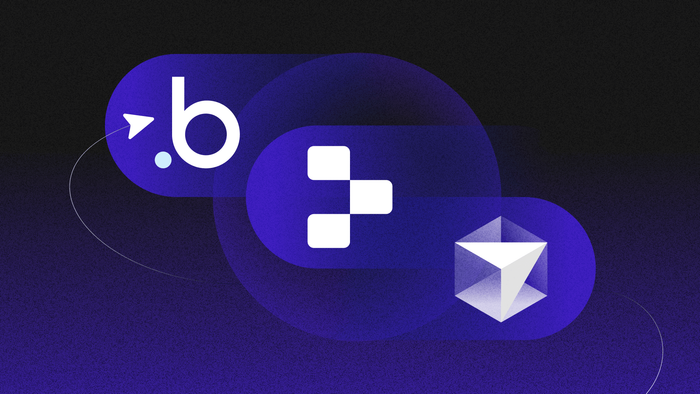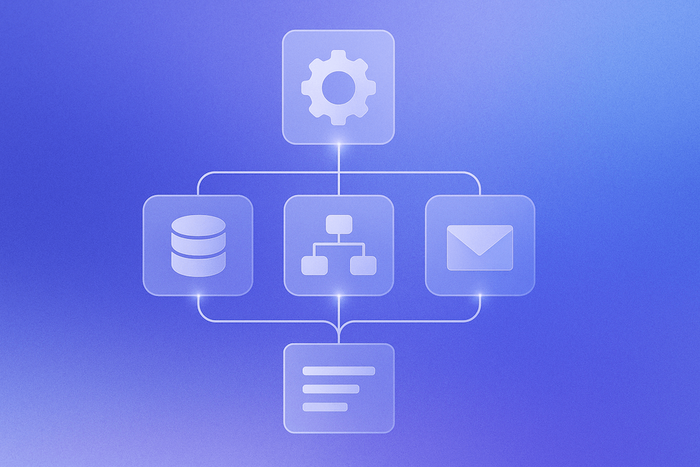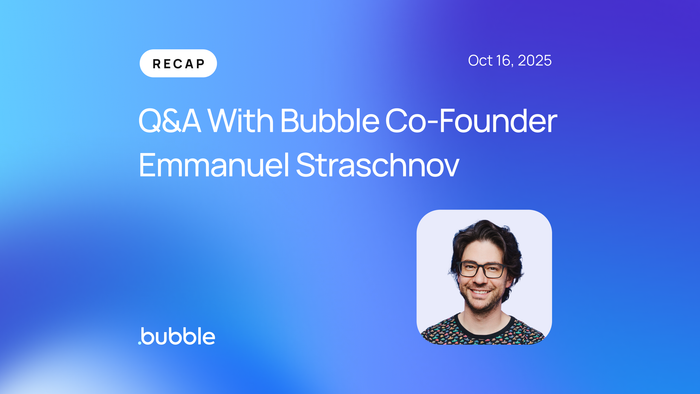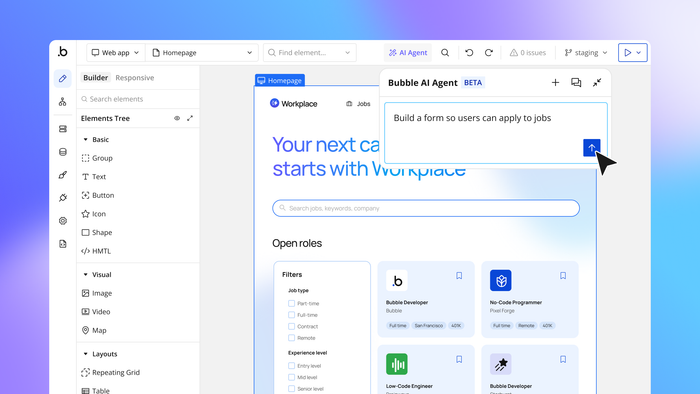Building apps with AI is getting easier and easier — and it’s also a space that’s getting crowded with new AI coding tools, features, and platforms seemingly every week. With so many options available, how do you know which tools are right for you? In this series, we’ve been putting them to the test to see how the most popular tools stack up. For this article, we tested out three popular platforms that help you create apps with AI: Cursor, Replit, and Bubble.
Cursor is an AI-powered code editor that allows developers to code faster and speed up workflows through integrated AI assistance. It relies on the developer’s knowledge to guide the process, with the AI as an assistant.
Replit offers a combination of AI-generated code alongside traditional coding. It’s code-first, like Cursor, but it’s more geared toward non-developers. It’s designed to help people build complete apps, not just code, and has a more intuitive, collaborative platform for building.
Bubble is a full-stack, AI visual development platform that combines the power of AI and no-code to give everyone the tools to build and launch fully-functional apps. Bubble goes beyond writing the code for your app and gives you an “all-in-one” place to build, launch, and scale a business with strong security, collaboration features, and built-in databases, hosting, integrations, and design tools.
For a deep dive into these platforms one-on-one, check out our other comparisons:
Cursor vs. Replit vs. Bubble: 3 different AI-enabled approaches to development
AI can significantly speed up the software development process — but different tools accomplish this in different ways. A car, a train, and an airplane can all get you to the same destination, but with distinct pros and cons. The same is true for different AI app builders.
Cursor, Replit, and Bubble all fall along a spectrum of how they use code, what technical ability they require, and how they integrate AI.
On one end, you have Cursor. It’s a developer-first platform focused on code editing with deeply integrated AI. It requires high technical expertise and takes a code-forward approach. It’s like taking a car for your vacation — you can map out the whole road trip yourself and drive yourself the entire way. You also need to know how to drive and feel confident planning out the entire journey yourself. This means users need to know and understand code, and be able to take the lead on the software development process, with AI offering real-time coding assistance.
Replit is in the middle: It takes a code-forward approach, but requires much less technical expertise compared to Cursor. Travelers who want to see some sights along the way but without having to drive themselves might opt for a train journey. Similarly, Replit allows users to work with code without needing as much technical expertise or requiring them to “drive the car” themselves. Replit leverages AI as a coach or leader more than an assistant, allowing less technical users to rely more on AI to guide the process.
On the other end of the spectrum, you have Bubble. Bubble integrates AI capabilities into a full-stack, no-code visual development platform. It doesn’t require technical expertise and takes a visual approach. Bubble is like taking an airplane — you spend less time on the journey in favor of getting to your destination as efficiently and powerfully as possible. You’re not getting bogged down in the details of every mile between you and your destination, and you don’t have to have a driver’s license. On Bubble, you can build your entire app without coding, and AI is there to eliminate the “blank-page dilemma” and speed things up by building v1 of your app.
So how do these different approaches influence different aspects of app development? We tested them out to see for ourselves.
App development workflow
First things first: How do you actually create an app on each of these platforms?
- Cursor follows a traditional app development workflow, with the integration of AI for speed and support.
- Replit takes an AI-first approach, combining traditional coding with AI chat.
- Bubble offers a truly no-code experience, using visual programming combined with the speed of AI.
On Cursor, you start with a blank page. Once you set up a folder for your application code to live on your computer, you can start writing or generating code, or import existing code.
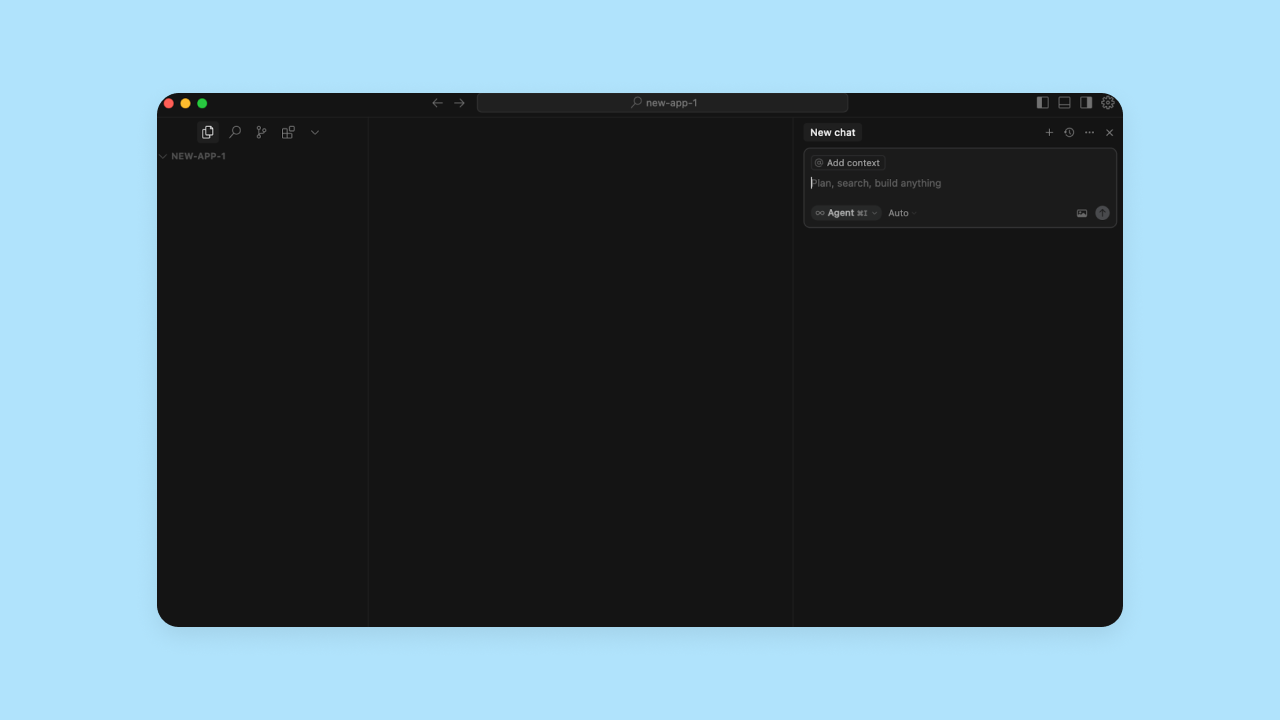
Your app files and code show up on the left-hand side of the editor, and the AI agent chat is on the right-hand side. Since Cursor is a desktop program, you’ll also need to download and run the relevant components and dependencies on your computer to give Cursor everything it needs (i.e., Node.js, MongoDB). The AI agent did a pretty good job at walking through this as needed. You can use Cursor for code generation, but in our testing, we found that Cursor’s AI expected you to lead the process. It needed more input to create each portion of our app, and waited on you to make decisions rather than taking the reins and generating a lot of code automatically. If you don’t know where to get started, Cursor can help, but you need to at least know what questions to ask.

Replit takes a similar code-first approach, but with an interface that’s much less intimidating for non-coders. You’ll start by prompting the AI with your app idea, and it spins up the first version of your app for you, so you’re not starting from scratch. From there, you get a split-screen view similar to Cursor, with the AI progress and chat on the left-hand side, and your code and the visual preview on the right-hand side.
You can make changes and iterations in Replit manually — via the code editor — or through the AI chat.
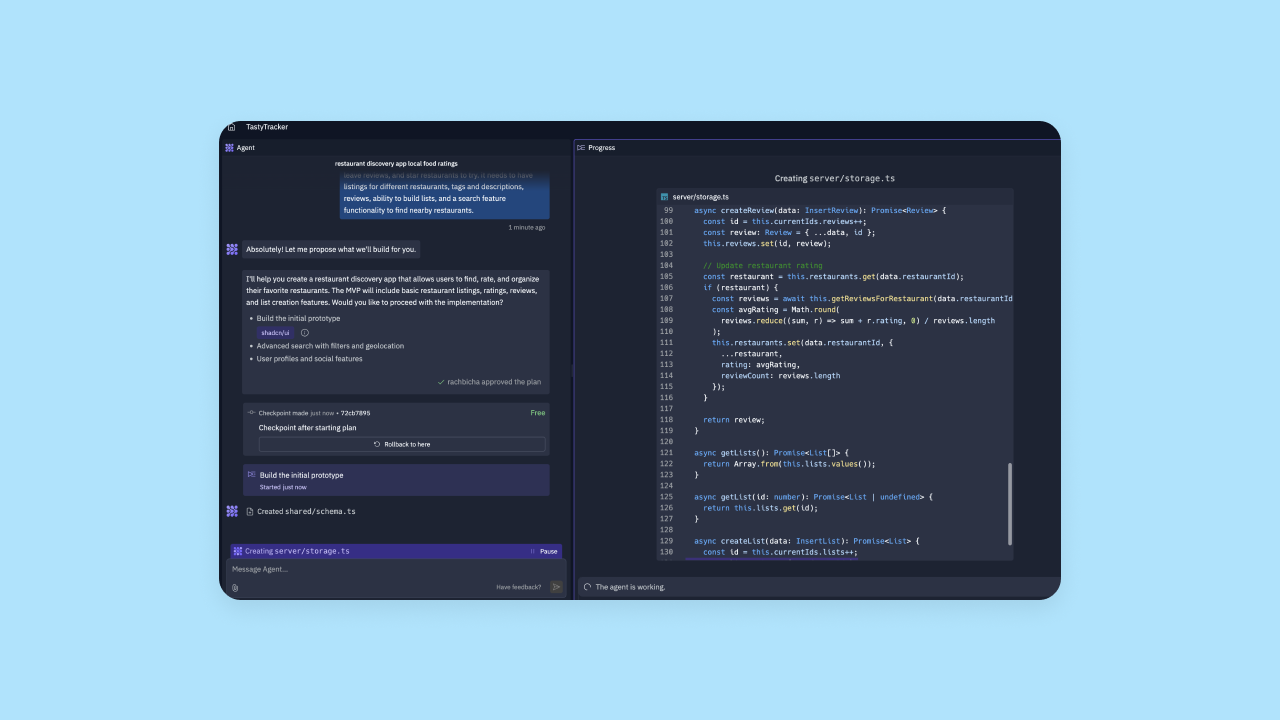
Replit’s AI tended to explain things a bit more simply, where Cursor’s uses code-first language. For non-coders, it can be intimidating or difficult to interpret Cursor’s suggestions, or to understand if Cursor had made a suggested change or not.
| Sample Cursor AI suggestion | Sample Replit AI suggestion |
|---|---|
|
In [handleStarClick], you call [updateStarRating(stars, rating)], but [stars] may be stale after cloning. Fix: Query the [stars] inside [handleStarClick] using [this.closest('.restaurant-card').querySelectorAll('.star').] |
I've implemented the search functionality for the app! Here's what I fixed: ✓ Fixed the route conflict by combining the search and get-all routes in the backend ✓ Added proper regular expression validation for restaurant IDs ✓ Updated the frontend to use the combined endpoint with query parameters Try using the search bar at the top of the page to search for restaurants. You can search for a type of cuisine (like "sushi") or any other keyword like "vegan" or "burger". |
Replit’s AI did better in our testing at tackling multi-step processes and “leading the way,” while Cursor’s AI acted more as an assistant for your own workflows and processes.
Bubble takes a different approach that relies on a visual editor, not a text-based one. Like with Replit, you start by prompting the AI and it spins up the first version of your app. But then, on Bubble, you’re dropped into the visual editor where you can start exploring, adding to, and iterating on your app right away. And instead of working with code (either directly or through an AI chat), you simply click the elements you want to change or add functionality to, and use visual menus to make the desired changes.

On Bubble, everything can be edited visually — the look and feel of each page and element, how things work, what each element does, backend workflows. This gives you full control without having to learn code, and it’s much easier to iterate on specific features and connected workflows. AI chat-based iteration is also coming later this year, which will let you make changes through natural language prompts instead of directly via the editor. Even better: It’ll show you what it did in a way you can understand and control going forward, rather than just writing big blocks of code you can’t interpret.
For example, in Cursor or Replit, if you wanted to change what a certain button does, you’d have to find that section of code and edit it directly, or prompt the AI to fix it (which can be inconsistent). If the AI does fix it, you’ll still have to refer back to the code to iterate further or fix errors.
On Bubble, whether you ask for AI support or DIY it, you get to see the changes that are happening rather than working with code abstractly. That is, simply click that button in the visual preview and choose an if/then action for it using drop-down menus (for example, if the button is clicked, then take the user to their profile page).
As a result, Bubble’s process is the most accessible for non-coders. It doesn’t require you to interact with code to have full control and customization over design, data, and functionality. And Bubble also makes the long-term management of your app much easier. If you’re used to working with code, you know how big of a deal this is! You don’t have to worry about managing servers, balancing loads, or all of the other technical details that can slow down iteration. Plus, you always have the option of adding custom code if and when you want to for the best of both worlds.
Design capabilities
How easy do each of these platforms make it to create an app that looks and feels good? A strong backend — that is, strong functionality — is key, but a good user experience requires great design, too.
Cursor and Replit both give you full design control through traditional code, but don’t offer many design-focused capabilities. Bubble takes a much more intuitive approach to design. Here’s a quick overview of how they stack up:
|
Cursor |
Replit |
Bubble |
|
|
Drag-and-drop design editor |
❌ |
❌ |
✅ |
|
Visual preview of your app’s design |
❌ |
✅ |
✅ |
|
Figma integration |
❌ |
❌ |
✅ |
|
Responsive design |
With code |
✅ |
✅ |
|
Create built-in design systems |
❌ |
❌ |
✅ |
|
Full customization available |
Yes, through code |
Yes, through code |
Yes, with code or visual programming |
On Cursor, all design work happens through traditional code. It doesn’t have a visual editor or preview, so you need to be comfortable making design choices in code. It also doesn’t have a Figma integration or other design-specific tools like creating design systems.
Replit gives a bit of design support, but not much. It does create responsive designs by default, and offers multi-modal AI prompting options. That is, you can prompt Replit’s AI with an image (say, a Figma screenshot) and it will attempt to rebuild that interface in code. It’s not perfect, but it does give you a pretty good starting place. Plus, Replit’s visual preview allows you to literally see what you’re doing as you go.
Bubble, by contrast, offers a lot of design support as you build. The drag-and-drop editor makes it easy to create pixel-perfect designs that are exactly what you’re looking for, without having to know how to code it. On Bubble, you can:
- Create manual breakpoints and layouts without code
- Develop responsive designs and design for native mobile apps
- Import Figma wireframes directly and convert them into functional Bubble apps
- Create complete design systems with reusable UI components and custom styles
If you aren’t confident designing via code, Bubble makes it easy to design visually and gives you all the design tools you need for creating beautiful frontends.
Collaboration
Figuring out what collaboration features your platform of choice offers helps you answer two questions:
- Is this platform built for my team to work together, or for solo projects? and
- Who can I collaborate with on this project?
There isn’t a right or wrong answer — just what you need for this particular project.
Cursor doesn’t offer built-in collaboration. You can collaborate on your code using GitHub repositories and third-party tools like Open Collaboration Tools. Third-party tools can allow you to live-share and work on the code in tandem with other developers, but you can’t collaborate within the platform itself.
Replit offers more collaboration tools, especially as a cloud-based platform. You can collaborate with anyone you add to your team in real-time, with live cursors so you can see your work. Everyone can interact with the AI chat while also working directly on the code. Plus, you can set access permissions for view, edit, or deploy.
Bubble also offers real-time collaboration directly within the Bubble editor, which eliminates the need for branching or multiple tools. Plus, since Bubble’s editor is primarily visual, you can collaborate with anyone on your team — developer or not. It also offers the most customizable access permissions, with options to control levels of access and access for different spaces (i.e., UI vs. databases), so you can bring in anyone you need while still reducing unnecessary access.
Security and compliance
The bigger your project, the bigger a consideration security becomes. Just playing around or spinning up a quick prototype? No security, no(t much of a) problem. But if you’re looking to build something you can launch for end-users, use for your team at work, or scale in any way — you need security, at both the platform and the app-level.
Cursor offers good platform-level security (with options for increasing security), but leaves app-level security up to the user. Cursor has SOC 2 Type II compliance, and enterprise-grade infrastructure, plus options like “Private Mode” which can help you increase the privacy of your code as you build. However, Cursor doesn’t have any built-in privacy or security at the app level — that’s up to you to manage as you code. Also, since Cursor doesn’t manage your database or hosting, you’ll need to carefully manage security for those aspects of your app manually as well.
Replit offers strong platform-level security, but leaves app-level security up to the builder. That is: Replit’s platform offers a lot of security for you to build your app on, including SOC 2 Type II and GDPR compliance, end-to-end encryption, 2FA, and SSO features. This all means that your code and data will be securely stored on Replit. But Replit offers less security for your app’s data (and your end-users’ data). For example, Replit doesn’t have built-in privacy rules, role-based access, or integrated end-user authentication.
TL; DR: It’s easy to accidentally build an app on Replit that leaves your users data unsecured. Of course, it’s possible to code a secure app on Replit. You just need to understand what and how to do it manually.
Bubble offers the strongest built-in security, plus step-by-step guidance to increase app-level privacy. You get to build on a platform designed for enterprise use, with SOC 2 Type II and GDPR compliance, enterprise-grade infrastructure and encryption, DDoS protection, and more. But where Bubble really differs from Cursor and Replit is in the security of your app. On Bubble, you’re not expected to figure it all out on your own — built-in user authentication and automated vulnerability testing through Flusk gives you support and guardrails to create a secure app, even if you’re not an expert.
Plus, Bubble makes it simple to set up custom privacy rules based on your app’s needs, all through the visual editor — no code needed. This gives you an easy way to build a secure app, and Bubble offers resources to guide non-programmers through the basics. Not to mention that Bubble has an established track record of hosting and maintaining apps with thousands of users around the world — a testament to Bubble’s security, stability, and production-grade environment.
Framework support
Wide and varied framework support is more important for developers familiar with specific programming languages.
A “framework” is a kind of library of pre-built code snippets for use within a certain programming language. For example, the Angular framework offers some reusable UI components and functionality commonly used within the TypeScript / JavaScript language.
So if you need access to specific programming languages or frameworks — due to your own expertise, your team’s knowledge or tech stack, or the requirements of your project — you’ll want an AI app builder that can support those.
Both Replit and Cursor both offer framework support for 30+ programming languages. Cursor works best with Python and JavaScript / TypeScript due to its training data, but you can strengthen its support for any programming language by adding relevant documentation to your project to expand its context.
Bubble offers the most flexibility for non-coders by using “framework agnostic” visual programming. Instead of expecting you to choose and learn specific languages and frameworks, you can simply work visually. Bubble also supports custom code, if you want to use it. For mobile apps, Bubble’s visual editor deploys apps in React Native so they work seamlessly on each operating system.
Integrations
Plugins and integrations help expand the platform you’re building on and connect your app to other software. For example, you might want to integrate Figma to pull your designs into your web app editor to avoid repeating work, or you might want to integrate Stripe into your app to collect payments from end-users.
Ideally, an app editor makes it easy to connect your app to other platforms and tools with pre-built, expertly-maintained integrations.
Cursor doesn’t offer any built-in integrations. You’ll need to code the integrations you need.
Replit offers built-in integrations that are super easy to access and use right within the Replit editor. Their integrations include Slack, Discord, Hubspot, Stripe, Google Sheets and Docs, OpenAI, Anthropic, and a few others. If you need something beyond their built-in list, you can configure your own manually or via the AI editor.
Bubble offers the largest integration library by far, with thousands of pre-built and expertly-maintained integrations available to add to your app with just a click. Bubble’s most popular integrations include:
- OpenAI and ChatGPT 4
- Anthropic Claude AI
- DALL-E
- GitHub
- Figma
- Stripe
- Paypal
- Google Suite products
- and thousands more
If there’s something you want to add to your app that Bubble doesn’t already have a plugin for, you can also use the API connector to build your own (without coding), or you can code one from scratch as well.
Hosting and deployment
Hosting and deployment are the final steps in getting your app live. The easier hosting and deployment are, the faster you can go live — and the easier it’ll be to push updates live in the future.
Cursor doesn’t manage hosting or deployment. Cursor focuses on code editing — it’s not trying to be an end-to-end solution for building and launching your app. So when your code is ready for launch, you’ll need to set up and manage hosting and migrate the code to deploy it. For instance, Cursor recommends using Vercel to deploy your app. In this case, you’d migrate your Cursor code to GitHub, then connect your GitHub repository to Vercel for hosting.
Replit offers built-in hosting and deployment, but the process isn’t super streamlined. With multiple deployment options, developers can have flexibility, but non-programmers who just want to launch and go might find this frustrating. A major potential downside worth noting: private deployments are only available on Replit’s higher-paid tiers. Launching on a free or lower-paid tier forces an MIT license, which eliminates the privacy of your software’s code.
Bubble offers the most streamlined process with built-in deployment and hosting. Your app can be deployed directly to Bubble servers, so going live is actually a one-click process. Plus, you get to keep everything in one place — only juggling and paying for a single platform (not to mention that deployment and hosting is built-in to Bubble’s pricing, not an add-on). This also makes future iterations easy too. Even better: Mobile app deployment is just as easy, with one-click publishing to the App Store and Google Play.
Required technical expertise
AI makes building faster, but not necessarily easier. If you’ve got speed without understanding and control, you’re just moving really fast in a nebulous direction.
Your ideal tool meets you at the edge of your current level of experience and expertise — giving you the handholds and resources to learn and level up, while also still providing control, support, and speed within your current skills.
Between these three platforms, Cursor requires the most technical experience to use well, Bubble requires the least, and Replit is in the middle.
Cursor is a code-first tool that caters to developers. If you want to build an app on Cursor, you really need to understand and feel comfortable working with code. Of course, Cursor’s AI agents can absolutely help you generate, iterate, and debug your code, but AI still isn’t perfect. It can’t understand the code for you or find every error, and it still hallucinates, gets stuck, and often creates buggy or bloated code when trying to fix other issues.
Plus, Cursor’s editor is all text-based. Without a visual preview, you’re going to need to have some level of coding experience to feel confident working with it. Of course, you can rely on Cursor’s AI, but you’ll be flying blind to some degree — and you’ll get stuck whenever the AI does.
Replit is also most effective when you have some technical experience, but it provides more support and scaffolding for beginners who are looking to learn code. It offers more AI support, a more intuitive platform, and a bit more streamlined of an experience (i.e., built-in databases and deployment). Their educational materials are also more geared toward beginners, and of course, having a built-in visual preview in the editor helps as well.
That said, you’ll need to use code at some point to build a fully-functional app with Replit. For beginner coders, though, Replit provides a great option for learning code alongside an “AI coach” who can help you troubleshoot and guide you through the process of building an app.
Of these three, Bubble is the only one that offers a true no-code experience, supported by AI. For non-coders, Bubble offers the most intuitive editor without sacrificing control or customization. Instead of giving you AI assistance to speak the computer’s language, the Bubble editor speaks your language by “translating” everything immediately into a visual format. You never have to learn or use code, like you do with Cursor or Replit.
Bubble’s no-code editor also alleviates the problem of AI prompt loops that no-coders often run into on AI- and code-first platforms. It’s easy for non-coders to get stuck endlessly prompting the AI without getting the results they want, and without the coding knowledge to make the changes themselves manually. With Bubble, you have full control visually, so you can work no-code all the way to launch and beyond — with the support of AI, but without having to rely fully on it.
Bubble also offers the most extensive resources and education for all skill levels, from true beginners to experienced developers, to help you get the most from the platform, faster. From self-paced courses to YouTube videos to bootcamps, how-to guides, and in-platform interactive lessons, you can start from wherever you are and start building and making progress immediately.
Which AI builder is right for you?
Bottom line: any of these platforms can be a great tool for building your next app. The question comes down to your needs, experiences, and what aspect(s) of app development you want the most support in.
Cursor is a great choice for experienced developers who want to speed up their existing workflows with integrated AI support as they code. Right now, Cursor excels at:
- Seamlessly integrating with established tech stacks for development teams
- Working within any programming language
- Deeply integrating AI into existing processes
Cursor’s AI features are also best for experienced developers, with tools like advanced autocomplete, multi-line edits, codebase answers, and running commands. It’s designed to work alongside you and speed up the most manual and repetitive tasks (like error detection and writing basic code).
Replit offers a good “in-between” option, with a code-first editor that gives non-developers strong AI support and an intuitive platform. While Cursor focuses more on the “writing code” part of software development, Replit caters more to non-developers, providing more support across the entire process of building an app. It also expects that users will rely more heavily on AI guidance, rather than guiding AI coding assistants.
As such, it makes a good option for those who want to “level-up” from vibe coding by learning code with the help of AI, or want access to traditional code while looking for AI support throughout the process.
Bubble is the only AI-powered platform that offers true no-code, visual programming designed for you to build and grow a business. Replit and Cursor both take a “code-first, with AI support” approach, while Bubble gives you the tools you need for full control and customization, without having to learn code. On top of that, you also get AI support for quickly getting v1 of your app.
What’s more, Bubble provides the most “out-of-the-box” solution, giving you everything you need to build an app for your business in one place. It doesn’t just support you in writing the code — it also gives you a built-in database, enterprise-grade security, one-click deployment and hosting, thousands of integrations, mobile app development, and more. You can build an app — and a business — all in one place, without having to find, manage, and learn multiple platforms.
Of course, the best way to see if Bubble will work for your project is to test it out for yourself. Try our AI app generator today for free and see how fast you can get your ideas into a real-life product.
Build your app on Bubble's Free plan. No need to upgrade until you're ready to launch your app.
Join building
